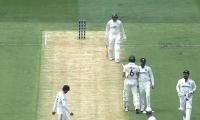Pakistani media either boycotted the anti-drone march or tried to cast it in a negative light.
A strong pro-US lobby exists in Pakistani government, politics and media. This lobby is a result of hard work by Washington over a decade, cultivating support through traditional PR and funding under different heads. Political rivalries are another explanation for the unusual animosity shown to the anti-drone campaign. These two factors – the pro-US lobby and political rivalries – combined to create confusion. The federal government, a coalition stitched together and maintained by American officials in the last days of the Bush administration, was successful in using the police and local civil administration to create physical hurdles. By night time, it was natural for the military to advise the marchers how darkness multiplied threats to a rally inside South Waziristan.
The government strategy was a success: waste daylight time by using obstacles on the road and then accuse the military of stopping the march at nightfall.
Dirty Pakistani politics aside, the Pakistani government continues to take a soft line on the CIA drone violations and the murder of innocent Pakistanis. Some official American leaks try to give the impression that the Pakistani military supports CIA drone attacks. But sentiments inside the military were on display last week at the National Defence University, where a representative of American anti-drone activists was invited for panel discussion with military officers. The government continues to hope that the US will transfer drone technology to Pakistan. That is not going to happen. Meanwhile, the drones continue to push our own citizens into the arms of TTP terrorists. The TTP terror group itself continues to survive Pakistani attempts to eliminate it, thanks to safe havens inside Afghanistan under US military watch.
The benefit of CIA drones is also questionable. Barring a handful of real targets, the remaining targets have been of questionable value, inaccurate or not worth the collateral damage and the repeated violations of Pakistani territory. The American claim that our tribal belt is a source of threats to US soldiers in Afghanistan is weak and easily refutable. All existing data and evidence show that American troubles in Afghanistan, including Afghan resistance to foreign occupation, are indigenous and not engineered from outside.
Not shooting down a drone, not refusing permission for the CIA to use our airspace, and reluctance to internationalise CIA border violations, all amount to tacit Pakistani consent. It is time now for the Pakistani government and military to question the arguments used by the US military to justify meddling in our tribal belt. The Pakistani government can retaliate by issuing its own realistic assessments of alleged Al-Qaeda strength on the Afghan border region, the alleged threat posed by our tribal belt to US security, and the alleged role of Afghan territory under US control in sustaining TTP terrorism inside Pakistan.
Email: aq@projectpakistan21.org
MPAs ask for their salaries and benefits to be at par with high court judges and exempt from tax
This system fosters and places premium on VIPs, facilitating VIP culture, which is alive and kicking
Imagine this waste covering over 15,500 cricket stadiums, piled three meters deep every year
If there is one thing that can be gleaned from politics today, it is that we no longer speak same language
Postman argues that “typographic mind” was yielding to “televisual mind”
Pakistan is well poised to meet opportunities that Artificial Intelligence will offer for developments in industries







